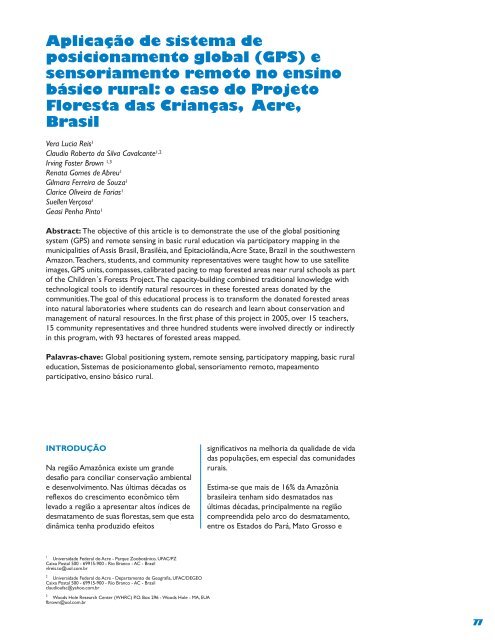La - Herencia
La - Herencia
La - Herencia
Create successful ePaper yourself
Turn your PDF publications into a flip-book with our unique Google optimized e-Paper software.
Aplicação de sistema de<br />
posicionamento global (GPS) e<br />
sensoriamento remoto no ensino<br />
básico rural: o caso do Projeto<br />
Floresta das Crianças, Acre,<br />
Brasil<br />
Vera Lucia Reis 1<br />
Claudio Roberto da Silva Cavalcante 1,2<br />
Irving Foster Brown 1,3<br />
Renata Gomes de Abreu 1<br />
Gilmara Ferreira de Souza 1<br />
Clarice Oliveira de Farias 1<br />
Suellen Verçosa 1<br />
Geasi Penha Pinto 1<br />
Abstract: The objective of this article is to demonstrate the use of the global positioning<br />
system (GPS) and remote sensing in basic rural education via participatory mapping in the<br />
municipalities of Assis Brasil, Brasiléia, and Epitaciolândia, Acre State, Brazil in the southwestern<br />
Amazon. Teachers, students, and community representatives were taught how to use satellite<br />
images, GPS units, compasses, calibrated pacing to map forested areas near rural schools as part<br />
of the Children´s Forests Project. The capacity-building combined traditional knowledge with<br />
technological tools to identify natural resources in these forested areas donated by the<br />
communities. The goal of this educational process is to transform the donated forested areas<br />
into natural laboratories where students can do research and learn about conservation and<br />
management of natural resources. In the first phase of this project in 2005, over 15 teachers,<br />
15 community representatives and three hundred students were involved directly or indirectly<br />
in this program, with 93 hectares of forested areas mapped.<br />
Palavras-chave: Global positioning system, remote sensing, participatory mapping, basic rural<br />
education, Sistemas de posicionamento global, sensoriamento remoto, mapeamento<br />
participativo, ensino básico rural.<br />
INTRODUÇÃO<br />
Na região Amazônica existe um grande<br />
desafio para conciliar conservação ambiental<br />
e desenvolvimento. Nas últimas décadas os<br />
reflexos do crescimento econômico têm<br />
levado a região a apresentar altos índices de<br />
desmatamento de suas florestas, sem que esta<br />
dinâmica tenha produzido efeitos<br />
1 Universidade Federal do Acre - Parque Zoobotânico, UFAC/PZ<br />
Caixa Postal 500 - 69915-900 - Rio Branco - AC - Brasil<br />
vlreis.to@uol.com.br<br />
2 Universidade Federal do Acre - Departamento de Geografia, UFAC/DEGEO<br />
Caixa Postal 500 - 69915-900 - Rio Branco - AC - Brasil<br />
claudioufac@yahoo.com.br<br />
3 Woods Hole Research Center (WHRC) P.O. Box 296 - Woods Hole - MA, EUA<br />
fbrown@uol.com.br<br />
significativos na melhoria da qualidade de vida<br />
das populações, em especial das comunidades<br />
rurais.<br />
Estima-se que mais de 16% da Amazônia<br />
brasileira tenham sido desmatados nas<br />
últimas décadas, principalmente na região<br />
compreendida pelo arco do desmatamento,<br />
entre os Estados do Pará, Mato Grosso e<br />
77


